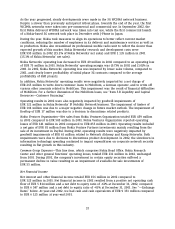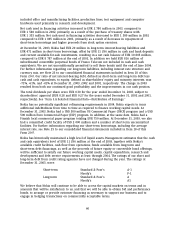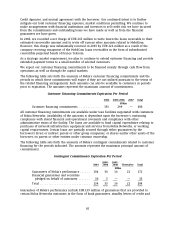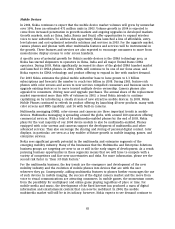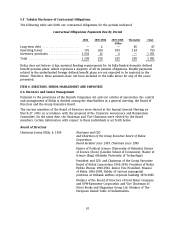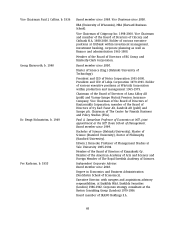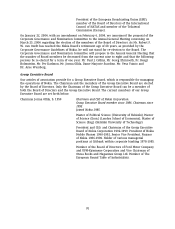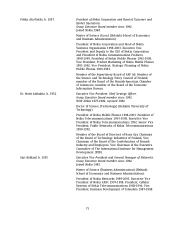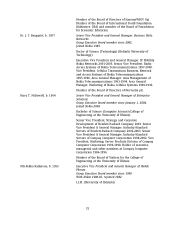Nokia 2003 Annual Report Download - page 66
Download and view the complete annual report
Please find page 66 of the 2003 Nokia annual report below. You can navigate through the pages in the report by either clicking on the pages listed below, or by using the keyword search tool below to find specific information within the annual report.Mobile Devices
In 2004, Nokia continues to expect that the mobile device market volumes will grow by somewhat
over 10%, from an estimated 471 million units in 2003. Volume growth in 2004 is expected to
come from increased penetration in growth markets and ongoing upgrades in developed markets.
Growth markets, such as China, India, Russia and Brazil, offer opportunities to expand wireless
voice to new subscribers. To address this opportunity Nokia launched a line of affordable, entry-
level phones and cost-optimized networks solutions and services in 2003. For the upgrade market,
camera phones and phones with other multimedia features and services will be instrumental in
the growth. These features and services are also expected to encourage consumers to move from
monochrome display screens to color screen handsets.
A specific area of potential growth for Nokia’s mobile devices is the CDMA technology area, as
Nokia has started shipments to operators in China, India and all major United States CDMA
operators. During 2003, Nokia significantly increased its share of the global CDMA handset market
and launched 11 CMDA phones. In 2004, CDMA will continue to be one of our focus areas, and
Nokia expects its CDMA technology and product offering to expand in line with market demand.
For 2003 Nokia estimates the global mobile subscriber base to have grown to 1.3 billion
subscriptions and forecasts the number to reach two billion in 2008. During 2003, feature-rich
phones with color screens and access to new services compelled consumers and business users to
upgrade existing devices or to move toward multiple device ownership. Camera phones also
appealed to consumers, driving new and upgrade purchases. The annual share of the replacement
market represented more than 60% of volumes in 2003, a trend Nokia intends to continue
capitalizing on by introducing a steady stream of new attractive mobile devices. In 2003, Nokia
Mobile Phones continued to refresh its product offering by launching 40 new products, many with
color screens and MMS capability, and 14 with built-in cameras.
Multimedia messaging (MMS), color-screens and cameras are three important trends in mobile
devices. Multimedia messaging is spreading around the globe, with around 180 operators offering
commercial services. With a total of 24 multimedia-enabled phones by the end of 2003, Nokia
plans for the vast majority of our 2004 device models to also be multimedia-enabled. Phones
equipped with color screens and cameras support the development of multimedia and other
advanced services. They also encourage the sharing and storing of personal digital content. Color
displays, in particular, are seen as a key enabler of future growth in mobile imaging, games, and
enterprise services.
Nokia sees significant growth potential in the multimedia and enterprise segments of the
emerging mobility industry. Many of the businesses that the Multimedia and Enterprise Solutions
business groups are targeting are new to us or still in the early stages of development. As a result,
pursuing business opportunities in these segments means that we will have to compete with a
variety of competitors and face new uncertainties and risks. For more information, please see the
second risk factor in ‘‘Item 3.D Risk Factors.’’
For the multimedia business, the key trends are the emergence and development of the new
mobility industry and the evolution of mobile phones into devices that are with the user
wherever they go. Consequently, adding multimedia features to phones further encourages the use
of such devices. In mobile imaging, the success of the digital camera market and the move from
voice to visual communications are attracting consumers. In mobile games, the momentum comes
from the possibility for multiplayer and online game playing regardless of place or time. For
mobile media and music, the development of the fixed Internet has produced a mass of digital
information and entertainment content that can now be mobilized. In 2004, the mobile
multimedia market will still be in its infancy; however, Nokia expects to see demand continue to
65




